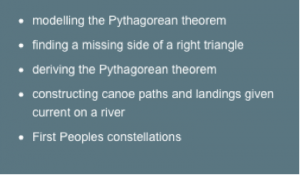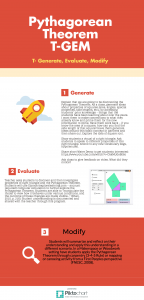Grade 8 Math: Pythagorean Theorem
One of the challenges I have encountered when teaching mathematics to Grade 8 students is their understanding of the Pythagorean Theorem. They are able to quickly memorize the “equation” but struggle with the conceptual understanding of the theorem. I have noticed that when students are given an equation they can usually solve it, but when given concrete objects or visuals they struggle. They also have the misconceptions that the Pythagorean Theorem applies to all triangles, and that the longest side of all triangles is the hypotenuse. I want to move students from general memorization to conceptual understanding.
B.C. Math 8 Content (2015):

Sorry for the small visual: details are below….

3 step T-GEM:
Generating:
Explain that we are going to be discovering the Pythagorean Theorem. As a class, generate ideas about properties of squares (area, angles, special properties, side lengths, etc.), by accessing students’ prior knowledge – things that the students have been learning about over the years. I want them to make connections to what they already know and prime them for the new information to come. Have them work back – if you know the area of a square, how can you find the side length of that square? Have them generate ideas around this basic concept in partners and then share out. Explore the idea of square root.
Show students a visual of a right triangle. Ask students to speak to different properties of this right triangle. Attend to any new vocabulary (legs, hypotenuse).
Share short Water Demo to get students interested: https://www.youtube.com/watch?v=CAkMUdeB06o
Ask class to give feedback on video. What did they notice?
Evaluating:
Teacher asks students to discover and then investigate properties of right triangle and the Pythagorean Theorem. Students will use Gizmos (explorelearning.com – account required) computer simulation to further explore the Pythagorean Theorem. Students are able to “manipulate the model to view how it behaves under various conditions, and the outcome of these changes are made visible…” (Khan, 2010, p. 216). Student understanding is documented and shared with the teacher through this program.
Modifying:
Students will summarize and reflect on their understanding and apply this understanding in a different scenario. In a Makerspace or Woodwork setting have students apply the Pythagorean Theorem through carpentry (3-4-5 Rule) or mapping or canoeing activity from a First Peoples perspective (FNESC, 2008).
References
British Columbia Ministry of Education (2015). Mathematics 8. Retrieved from https://curriculum.gov.bc.ca/curriculum/mathematics/8
First Nations Education Steering Committee – FNESC (2008). Teaching Mathematics in a First Peoples Context: Grades 8 & 9. Retrieved from https://teachbcdb.bctf.ca/download/271?filename=math-first-peoples-mapping-and-transportation.pdf
Khan, S. (2010). New pedagogies for teaching with computer simulations. Journal of Science Education and Technology, 20(3), 215-232.
SaveSave
Your post reminded me of an activity we did in Education, where we constructed grids for each leg of the triangle corresponding to the area. For example, for a 3-4-5 triangle, we created a 3×3 and a 4×4 grid on each side of the triangle. We then moved the tiles over to perfectly match the 5×5 grid on the hypotenuse. Cool seeing the areas visually though students do need to transition towards mental representations.
Andrew
I love the idea of transferring their learning to a Maker Space with a First Nations perspective. A perfect example of cross-curricular, deep-learning. I haven’t used Gizmos before so I am going to look into this. Thanks for sharing.
Like Danielle, I really appreciate how you have ended the lessons with two different connections and made cross-curricular learning happen. Well done. I wonder have you ever done this lesson with students? I wonder what they thought, it is so different from how I was taught, I wonder if they resist the activities or embrace them? Great lesson.
Hi Sarah,
I have done parts of the lesson but not altogether as I haven’t taught math 8 for a few years 🙁
When I did teach it I did add the building component and so we had students measure and build ramps. That was a lot of fun and they brought home great pieces to have conversations with at home with their families. I have not tried the First Peoples’ canoeing activity – though I’m hoping to get the opportunity to work with some of our grade 8 math classes next year.
I have also used Gizmos with my math students – which they enjoy as long as you don’t give them all the “worksheets” that go with it. I didn’t use Gizmos all the time, but did like this one.
Hi Natalie
My teaching job was Mathematics 8 — I had to relearn things that I had not used in over 20 years. Sometimes I was a couple of days ahead of my students 🙂
I like the fact that you shared you shared the youtube video – a very simple concept, but difficult to make.
I wonder if, after leaving school if people use the Pythagorean Theorem in their day to day life. When we remodeled our kitchen (L-shaped), I was reminded by the contractor to use the Pythagorean Theorem to make sure the cabinets were squared.
A good next step might be to begin to aggregate the plans for making aids that teachers have made for their classrooms.
Christopher
I definitely use with with carpentry! Our woodwork teacher showed me how to do it and I use it around the house 🙂
I enjoyed reading about your plan to teach the Pythagorean Theorem to grade 8s, and when I taught it to the class this year, I took a similar approach. Before teaching them the theorem, I thought it was important for students to remember what it means to square a number, and the geometric meaning of it (finding the area of the square). Another concept that was important was the order of operations, as students needed to work out the exponents before adding them together. I enjoyed Gizmo and would consider using it to teach the Pythagorean theorem the next time I do teach it, and I find the use of Makerspace and wood working a very applicable way for students to utilize the theorem.